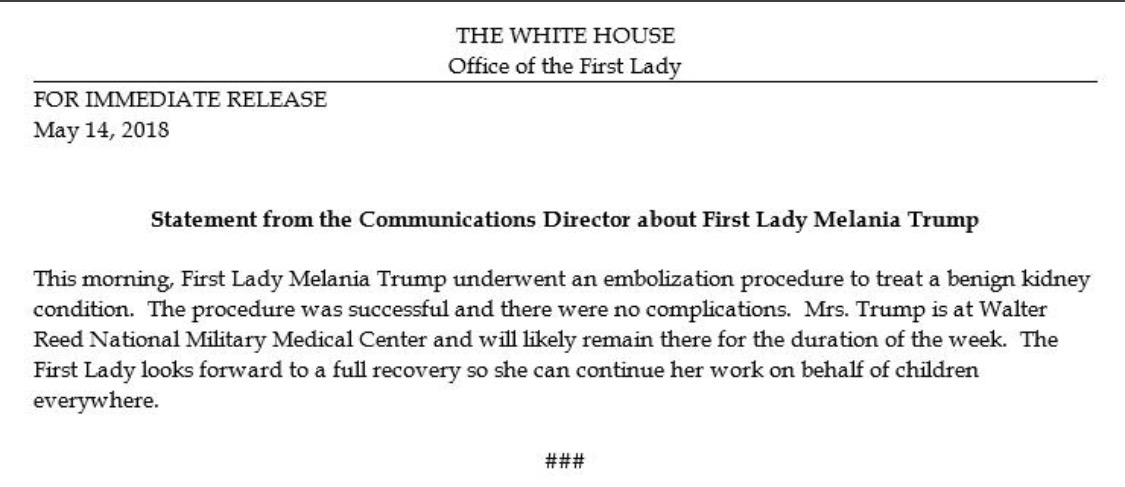In a statement just released by the office of the First Lady, Melania Trump is recovering well at Walter Reed National Military Medical Center after undergoing a “successful” embolization procedure today without complications for a “benign kidney condition.” Mrs. Trump will remain in the hospital this week. She is expected to make a “full recovery.”

If a kidney condition is benign, then why intervene?
There are a number of benign kidney conditions ranging from cysts to tumors. For instance, angiomyolipomas are a common benign tumor in this location. These are composed of blood vessel (“angio-”), smooth muscle (“myo-”) and fat (“lip-”) cells. Issues arise when such a mass grows large enough that it can cause impaired kidney function or be at risk of rupture or bleeding. The secondary concerns those eventualities can create can do significant damage (e.g. in extreme cases cause shock or lead to chronic kidney disease), so the goal is to avoid such scenarios entirely. As of now, there is no information released regarding the type of "benign kidney condition" the First Lady has that warranted such intervention.
What is an embolization procedure?
Embolization procedures are designed to use special materials threaded through the vasculature (or bloodstream) and strategically positioned to cut off the blood supply to a cancerous or benign but growing tumor, for example. In effect, they starve the targeted tissue. They are typically employed when less invasive access to the problematic area is possible. Open surgical resections or interventions tend to carry somewhat greater risk and protracted recoveries. When a medical treatment can be performed through interventional radiology and blood vessel navigated techniques, though they are not completely without risk, they can be preferable to the alternative.
Why would someone stay in the hospital for a period of time after such a procedure?
In the situation of such a procedure’s use for a benign kidney condition, it would be a matter of routine to monitor a patient closely to be assured that the kidney itself was properly functioning and not adversely impacted by the embolization (e.g. monitoring blood pressure, kidney function). Typical post-operative measures (e.g. pain management, infection control, anesthesia effects if general vs local) would also be conservatively observed to prevent any complications. (To learn more about the post-operative period, in general, see here).
Why does this reflect medical progress?
Years ago, such conditions were treated with major surgery that often involved removing large parts of the kidney. Now, this can often be avoided. Embolization procedures are not limited to the renal system or to benign tumors. They can be utilized to shrink a mass so as to make it more resectable by conventional surgery. Neurosurgery has been employing these techniques, for many years, within the neurovascular system for brain aneurysm and arteriovenous malformations, for example. The same is so for other organs. But, it is important to realize that not every disease state or patient is a candidate for it and it does have risks.
When we hear the word “embolus” we tend to think of the pathological effect of a clump of cells gone rogue wreaking havoc on the body in the form of strokes or a pulmonary embolism. In therapeutic embolization, medical professionals have usurped this power and employed it for the good of the patient in a controlled and constructive fashion. This reflects tremendous advance that has already taken place and the anticipated progress in the future seems incredibly bright.




